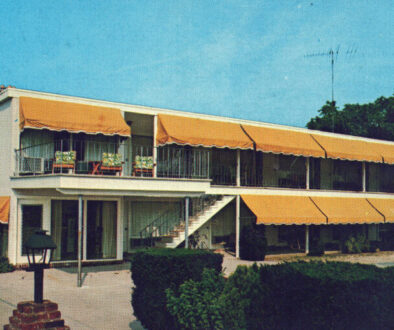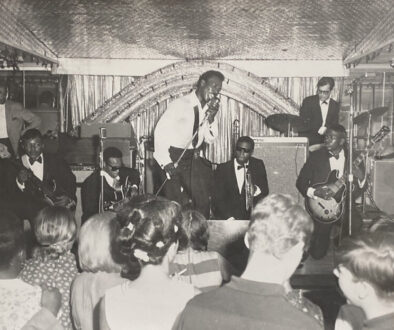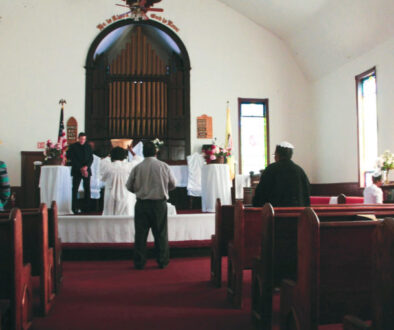A Prompt for Restoration
A year ago, Ron Goldstein, then president of Cape May’s Chamber of Commerce, knew little about Stephen Smith and the summer home he built on Lafayette Street in 1846. And whenever Goldstein passed it on his way downtown, he could barely see the building behind the shrubs and trees that obscured it. But last year when he read in this magazine about Smith’s role in the Underground Railroad and his leadership in the fight to end slavery, Goldstein was inspired. He knew he needed to do something to make Smith’s contributions more visible to the Cape May community. As head of the Chamber, he found a way to do just that.
Goldstein thought the Chamber could help beautify the house as part of its community outreach program. He proposed that the Chamber landscape the large area around the house, and the Chamber’s Board enthusiastically endorsed the plan. Goldstein asked Bernadette Matthews, now the Chamber’s First Vice President, to coordinate the effort. “Stephen Smith’s contributions to the country made it a worthwhile project,” explains Matthews. “We wanted to do our part in beautifying the site and building a sense of community doing that.”
Smith’s home is one of the few remaining buildings of what was once a vibrant and large African American community, comprising close to 30 percent of Cape May’s population in the early 20th century. By bringing the home to the community’s attention—both local and visiting—it “makes for a more comprehensive history…It is in a visible place, but it was obscure,” says Matthews.
In addition to making the house more noticeable, the Chamber has also made Stephen Smith and his place in history more visible when they included a full page about Stephen Smith in the latest edition of The Visitors Guide of Cape May.
As detailed in the Fall 2015 issue of Cape May Magazine, Smith was one of the richest black men in America before the Civil War, operating a coal and lumber business in Columbia, Pennsylvania and investing in real estate in Philadelphia and Cape May. In an era of intense hostility against free blacks in the north, when they struggled merely to find jobs, his ability to operate one of the most successful businesses was particularly remarkable.
He could have been content with that achievement. But with a flood of people fleeing slavery, Smith felt it his sacred duty to help them, at great risk to himself. He and his business partner and relative, William Whipper, built a false end to their rail cars to hide people. Along with their coal and lumber, they ferried hundreds of people further north on their way to freedom in Canada.
Smith was also a founder of the Pennsylvania Anti-Slavery Society, an affiliate of William Lloyd Garrison’s national organization, and was involved with many protests and activities demanding an end to slavery. He also played a key part in coalescing free blacks in northern states to demand their civil rights, especially the right to vote.
The Cape May Magazine article also detailed the efforts underway to restore the house by the four siblings who presently own it. They want to use it to retell Smith’s story through tours and presentations. In 1932 the Hampton family bought the house for $1 from their close friend, Smith’s grandniece. In the late 1960s, when the house was slated for demolition under the town’s controversial urban renewal plan, Amelia Hampton, mother of the current owners, saved it by sending an emergency telegram directly to President Lyndon Johnson.
Jo-Anne Hampton is leading the family effort to restore the house, but she lives in California and at times she feels far removed from life here. Although she gets back from time to time to Cape May, where she spent most of her early summers, she says the Chamber’s activity has inspired her own efforts.

“Sometimes I feel that I am doing things alone and I have a vision but no one else shares it,” she says. “But then I realize I am not alone. I have people I haven’t even met—people like Ron Goldstein—taking care of day-to-day things to help me continue what I am doing. The community benefits, the city benefits. It brings new life, brings somebody back from the 1800s, their philanthropy and work.”
The work is being authorized through the Chamber’s outreach program, created to convey the business community’s commitment to the city as a whole. In addition to providing scholarships to high school students, the Chamber selects nonprofit organizations each year to support. In 2015, the Chamber organized fundraisers and donated money to both Animal Outreach and the Cape May Food Closet.
The timing was auspicious for Goldstein’s proposal to begin to beautify the grounds of the Stephen Smith house. This year the city has grant money to significantly upgrade the parks along Lafayette Street, and a nonprofit helped the city to build a new gazebo and fountain, along with benches and plantings, at Rotary Park. The Stephen Smith house is one of the few private residences between the two park areas on Lafayette Street. Everyone on the Chamber’s Board agreed that landscaping it and drawing attention to such an important historical figure enhances the gateway to the city.
To that end, Good Neighbor Detail Management owner Annie Lentz is donating her professional landscaping services to the project. Her staff spent several days this past spring removing shrubs, trees, and lots of weeds that had overtaken the large yard on the side of the house. Lentz designed the plantings to be in keeping with the Victorian era of the house, putting in lavender plants, a favorite of the period, as well as daisies, along the front porch. To soften the box-like appearance of the simple structure, she has planted hydrangeas on one side of the building. She plans a kitchen garden with basic herbs, including parsley and rosemary, and will add other bushes and shrubs.
Cape Island Home and Garden is providing the plants at a discount. “We want to preserve the history of Cape May; that’s what this is all about,” says Judi Bernard, co-owner with Cindy Franklin, of the garden center. “I’m kind of a history freak.” Bernard adds that she owns a home not far from the Stephen Smith house, which dates back to his time. A long-time Cape May family had owned it, and she thinks it’s likely that they knew him. “We should continue the connection,” she says.

Lentz planned a garden area around a Victorian style metal bench, donated by TreeHouse Antiques, which is owned by Susan DeMaio and Wayne Stewart. When Lentz asked if they wanted to be involved with the project, they readily agreed. “We all need to work together,” Susan said, “and this is a small way my husband and I can contribute to that.” In addition, a birdbath was recently donated by the Eldredge House in West Cape May.
Jo-Anne Hampton also sees Stephen Smith as a unifying force. “We as a community are more connected by him (Smith) than I ever would have imagined,” she says. And she is thankful that the restoration will “recognize someone so important. It reminds me that one person in a community can do great things. Even now he’s a connecting factor.”
While many of the pieces have fallen into place to improve the appearance of the Steven Smith House, Ron Goldstein said that the project is certainly not yet completed. He indicated that plans for additional landscaping have been drawn up that include a driveway and possible hedge to be added by Spring 2017.



